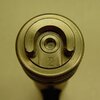I always shoot for .003 to .005 below flush just like the Lyman manual says.
Just curious how far below flush has been successfully shot.
After a member her mentioned a problem in another thread, I was very surprised to find some factory 40 S&W defense ammo with the primers between .006 and .010 below flush.
Most everything I shoot is out of a Glock and I’ll be testing with the lowest primers first to use them up, if they’ll fire. Would you reject the .006 cartridges or call it close enough to spec? I’m not in dire need to use this ammo, only curious what you guys have been able to successfully fire.
Just curious how far below flush has been successfully shot.
After a member her mentioned a problem in another thread, I was very surprised to find some factory 40 S&W defense ammo with the primers between .006 and .010 below flush.
Most everything I shoot is out of a Glock and I’ll be testing with the lowest primers first to use them up, if they’ll fire. Would you reject the .006 cartridges or call it close enough to spec? I’m not in dire need to use this ammo, only curious what you guys have been able to successfully fire.









